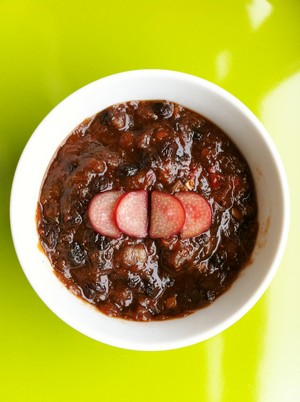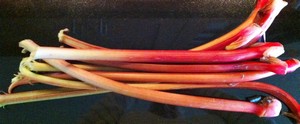 The Accidental Locavore is rhubarb neutral. If you show me an interesting use for it like this rhubarb upside-down cake, great. Otherwise, ho-hum. My cousin Ellen makes a delicious rhubarb chutney which marries the rhubarb with ginger, spices and brown sugar. It’s a great accompaniment to grilled or roasted meats, sandwiches or burgers. Her favorite way to serve it is on a cracker with sharp cheddar cheese (like this Cabot Clothbound Cheddar). The Accidental Locavore likes to wait until we’re back to winter squash and use it to top roasted butternut squash. Here, we’re going to give you the canning version of the chutney. If it looks too daunting, click here for the Accidental Locavore’s, fresh, eat-it-now version. A big thank-you to Ellen for this week’s locavore recipe!
The Accidental Locavore is rhubarb neutral. If you show me an interesting use for it like this rhubarb upside-down cake, great. Otherwise, ho-hum. My cousin Ellen makes a delicious rhubarb chutney which marries the rhubarb with ginger, spices and brown sugar. It’s a great accompaniment to grilled or roasted meats, sandwiches or burgers. Her favorite way to serve it is on a cracker with sharp cheddar cheese (like this Cabot Clothbound Cheddar). The Accidental Locavore likes to wait until we’re back to winter squash and use it to top roasted butternut squash. Here, we’re going to give you the canning version of the chutney. If it looks too daunting, click here for the Accidental Locavore’s, fresh, eat-it-now version. A big thank-you to Ellen for this week’s locavore recipe!
A word about all the canning steps described: It seems like a lot of work, but every step has a purpose in preventing bacterial growth and keeping your food safe. Ellen has her doctorate in Public Health, so she knows what she’s talking about. For example: people say jars will seal on their own without the water bath process. This is true, but the purpose of the water bath is to sterilize the air-space in the jar, not to seal it—without the water bath, rogue bacteria in the air may poison your carefully prepared preserve. And while it used to be safe and easy to sterilize jars in the dishwasher, today’s energy saving models may not have the sanitizing feature.
With canning, you really don’t want to fool around and make a potentially lethal mistake. Don’t improvise, and don’t skip a step—no matter what your mother tells you.
Makes about 7 half-pints.
Special Equipment for canning:
- Canning jars (pint or half-pint), free of nicks or cracks, washed in hot soapy water (you can re-use jars and bands but not lids)
- Lids and bands, washed in hot soapy water
- A large pot with a lid and a rack for sterilizing and canning
- A metal bowl for sterilizing lids and bands
- A canning funnel
- Canning tongs
Ingredients:
- 2 lbs. rhubarb, washed, drained and cut into 1/2″ dice (about 6-7 cups)

- 1 ½ cups coarsely chopped onions
- 4 cloves minced garlic
- 2 tablespoons minced fresh ginger root (peeled)
- 1 ½ cups raisins or currants
- 1 ½ cups dark brown sugar (packed)
- 1 tablespoon non-iodized salt, or pickling salt (kosher salt is non-iodized)
- 2 teaspoons mustard seeds
- 1 teaspoon ground allspice
- 1 teaspoon ground coriander
- ½ teaspoon dried red pepper flakes
- ¼ teaspoon ground cinnamon
- ¼ teaspoon ground cloves
- 2 cups cider vinegar
Prepare the jars. Select a large pot or kettle with a lid that will hold them all and fill it with water. (With small jars I use a pasta pot with a strainer-liner. Or you can put a rack in any pan so that the jars will not touch the bottom of the pan—they should be slightly elevated over the bottom of the pan, and when submerged water should cover them by about 2″.)
Make the chutney. In a large non-reactive pot or Dutch oven, combine all of the ingredients except the vinegar. Mix well, and bring to a boil. Lower heat and partially cover to simmer for about 30 minutes, stirring occasionally, until onions are translucent.
Remove the cover. Add the vinegar and cook over medium heat, stirring almost constantly, until the chutney is slightly thick and mounds up on a spoon, about 20-30 minutes.
While the chutney cooks, put the clean, empty jars in the canning pot filled with water. Cover the pot and heat until boiling. Boil the jars for ten minutes to sterilize, then either leave in the water, or remove them from the kettle and keep filled with water until right before you fill them (use canning tongs to move them). To sterilize the lids and bands, put them in a large metal bowl and pour a kettle of water just below boiling temperature to cover them. Let them sit covered in water until ready to use.
When the chutney is ready, use a very clean ladle or cup and the canning funnel to fill prepared sterilized jars to within 1/4″-1/2 ” of top. Have a couple of clean kitchen towels handy. Wipe jar rims, lids and bands. Put a lid and band on each jar. Screw bands on only until hand-tight.
Put filled, capped jars back in the kettle with water to cover 2″ above jars. (Remove some of the water to accommodate the filled jars.) Heat to boiling. Process by boiling 10 minutes for half-pints, and 15 minutes for pints. Turn off heat and carefully remove from the water bath using canning tongs, and cool on a rack. Label, date and store. Store at least three weeks before serving to allow flavor to develop.
